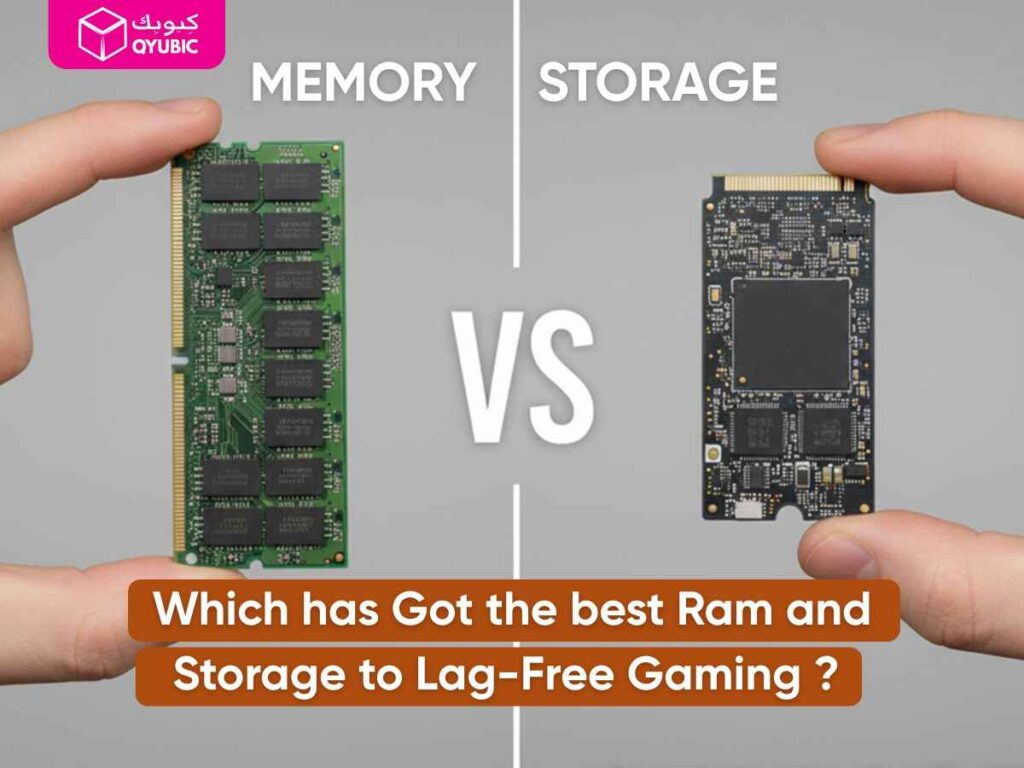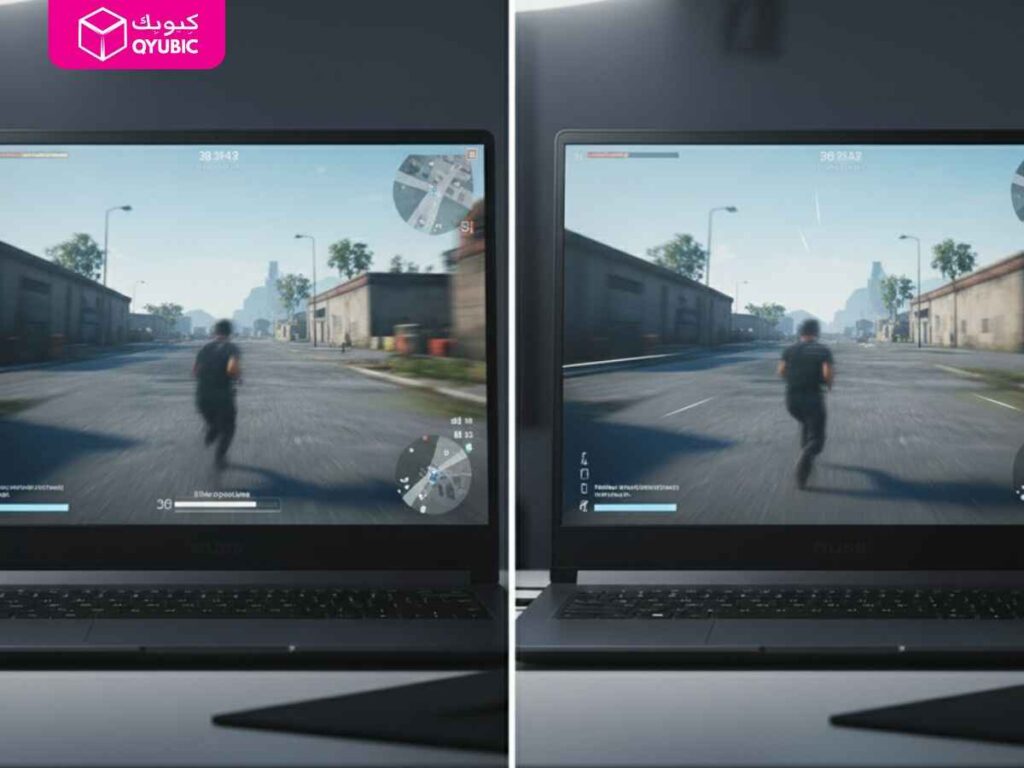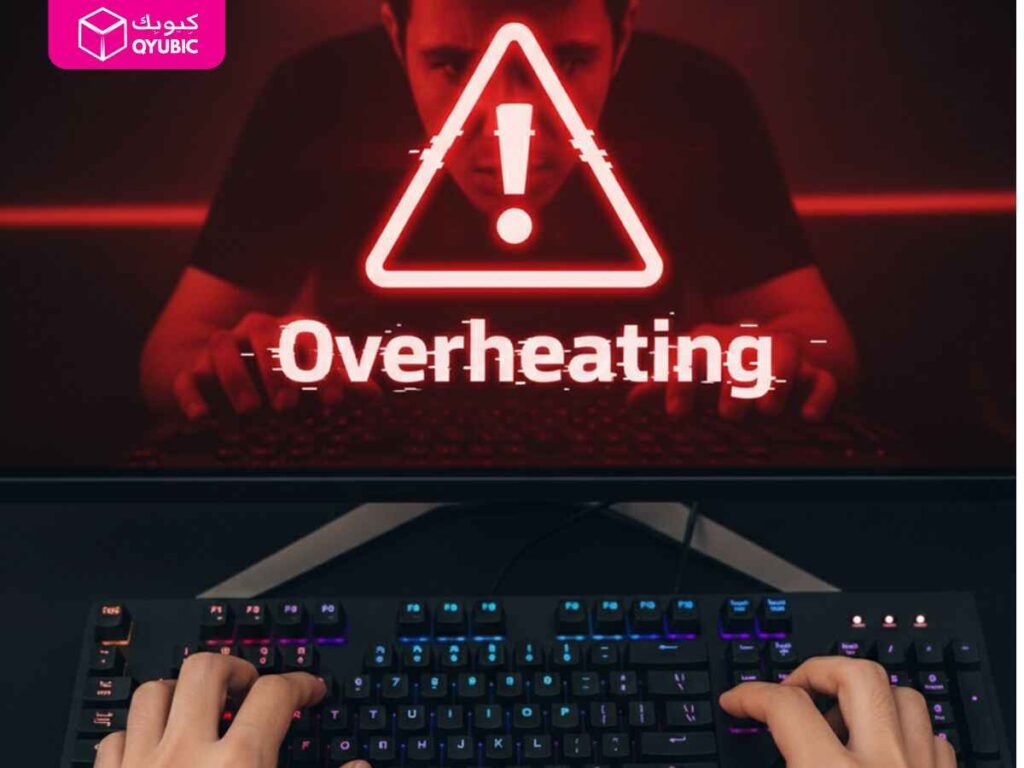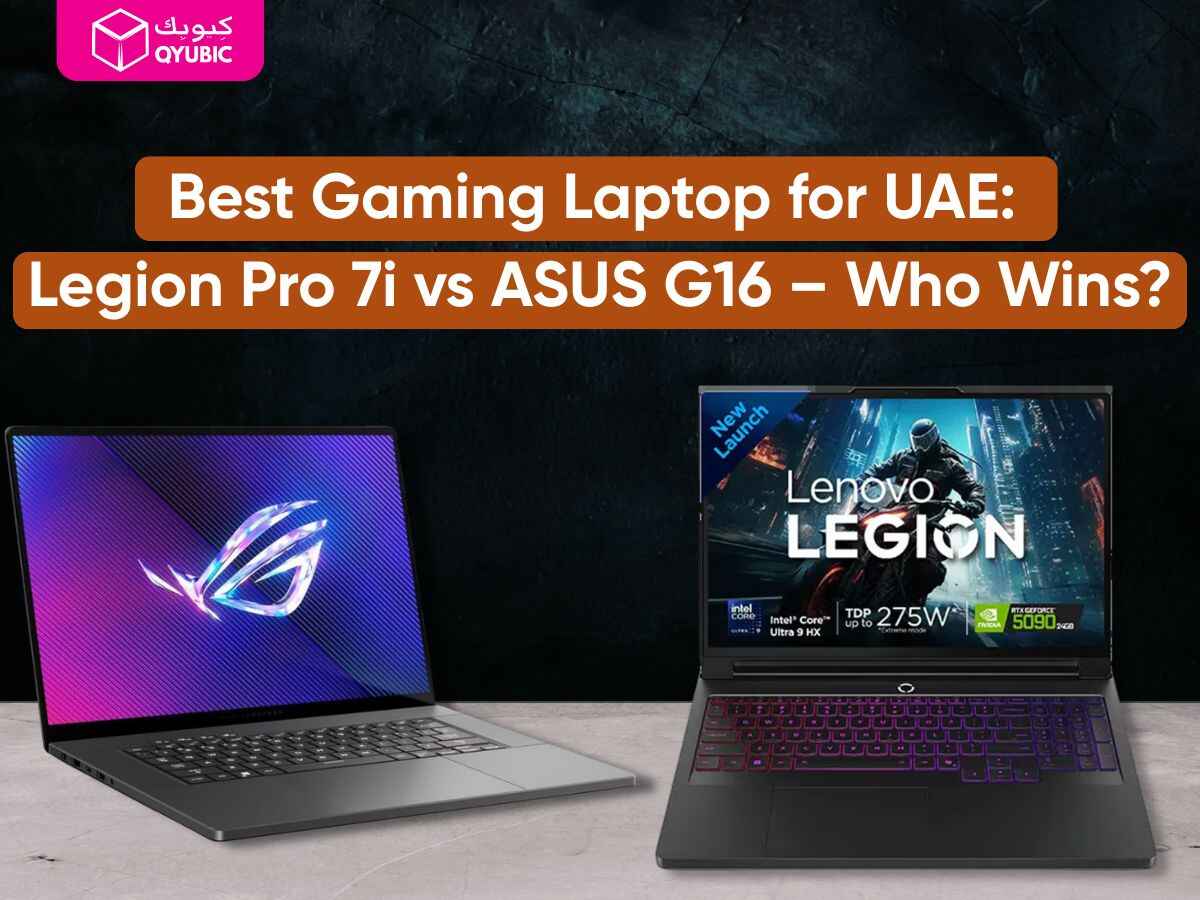A premium Gaming laptop is only as good as its performance under pressure—low frame rates, dim screens, or overheating can make intense gameplay unbearable.
In this comparison of the best gaming laptops, we’ll look at two powerful models—Lenovo Legion Pro 7i vs ASUS ROG G16—to see which one delivers the best performance during long hours of gaming sessions. From competitive shooters to AAA adventures, we highlight which laptop excels in each scenario. Don’t miss out on the top gaming laptop deals—use the Carrefour promo code by Qyubic to save up to 40% on premium models!
Get access to even more top gaming laptop deals and savings in the Qyubic electronics coupon section.
Checklist: Top Premium Gaming Laptop Features for UAE Gamers

For UAE gamers, choosing the best gaming laptop means looking beyond flashy RGB lights and high-end specs. The unique UAE climate, combined with a fast-paced student lifestyle and a growing competitive gaming culture, demands premium gaming laptops with top-tier cooling, battery life, and performance.
1. Processor (CPU) Performance
| Feature | What to Consider | Why It Matters for UAE Gamers |
| Core Count & Speed | Modern laptops use Intel 13th/14th gen or AMD Ryzen 7 7000 series. | Premium gaming laptops with high core counts ensure smooth multitasking for gaming, studying, and streaming. Fast cores improve performance in CPU-heavy games. |
| Gaming Benchmarks | Look at FPS differences in popular titles. | Intel shows slightly better single-threaded performance; AMD excels in multi-threaded tasks. Both deliver excellent gaming experiences. |
| Thermal Efficiency | Check for CPUs with dynamic frequency scaling and heat management. | UAE heat can reduce CPU performance by 10-15%. Proper thermal design prevents throttling during long sessions. |
| Battery Life | Efficiency of the CPU affects productivity battery life. | AMD Ryzen CPUs often provide ~15% longer battery life for academic or light use. |
2. Graphics Card (GPU) for Competitive Gaming
| Feature | What to Check | Specific Considerations |
| Performance in Popular Games | Compare FPS for RTX 4060/4070 or AMD Radeon 6600M/7600M. | High-end GPUs maintain smooth gameplay even in competitive esports titles like Valorant, Apex Legends. |
| Ray Tracing & DLSS | Check support for DLSS 3 and RTX features. | DLSS boosts frame rates in demanding games, helping maintain smooth performance in high ambient temperatures. |
| Thermal Management | Ensure laptops have efficient GPU cooling. | Prolonged gaming in UAE heat can reduce GPU performance by up to 10%. Adequate cooling keeps FPS stable. |
3. RAM & Storage
- RAM: Minimum 16GB recommended; dual-channel setups improve performance by 7-10%. DDR5 offers higher speeds and better efficiency, which translates to longer battery life.
- Storage: NVMe SSDs drastically reduce game loading times (e.g., Shadow of the Tomb Raider in 6.7 seconds). 1TB is ideal for balancing large game libraries and study materials.
- Upgradability: Look for laptops with accessible SODIMM and M.2 slots for easy RAM and storage upgrades. Future-proofing is essential, especially for UAE students who plan to keep their laptop for 4-5 years, ensuring it remains efficient for both gaming and productivity.
4. Display Quality
| Feature | What to Look For | Gaming Impact |
| Resolution | 1080p for standard gaming; 1440p for high-refresh competitive gaming. | 1440p is a sweet spot for RTX 4060-class GPUs; 4K is still very demanding. |
| Refresh Rate | 144Hz for fast-paced titles, 240Hz for esports. | Higher refresh rates reduce input lag by up to 40%, giving a competitive edge. |
| Panel Technology | IPS panels with 1ms response time preferred. | Balances color accuracy and fast response times; TN panels may sacrifice visuals for speed. |
5. Cooling & Stability
- Advanced Cooling: Look for dual/triple-fan systems, heat pipes, or vapor chambers.
- Thermal Throttling: Effective cooling keeps CPU <85°C and GPU <75°C during long sessions.
- UAE Climate Adaptation: High ambient temperatures can increase internal temps by 10-15°C. Cleaning dust filters and using cooling pads can improve performance by ~10%.
6. Battery Life & Fast Charging
- Gaming vs Productivity: 1.5-3 hours during gaming; 6-8 hours for light productivity.
- Fast Charging: USB-C PD 3.1 can reach 80% in 60-90 minutes; ideal for students with mixed gaming and study schedules.
- Battery Heat Management: High UAE temperatures can reduce battery efficiency by 15-20%, so larger batteries (80+ Wh) and efficient CPUs are preferred.
7. Upgradability & Future-Proofing
- RAM & Storage Expansion: Many laptops support 32-64GB RAM and dual NVMe drives.
- Accessibility: Basic tools like Phillips screwdrivers usually suffice to upgrade components.
- Long-Term Value: Start with 16GB RAM and 1TB storage; upgrade later for cost-effective longevity.
8. UAE-Specific Gaming Considerations
- Heat Management: Effective cooling pads, proper ventilation, and avoiding soft surfaces are essential to prevent overheating, especially in the UAE’s high temperatures.
- Popular Games: PUBG, Fortnite, FIFA, Call of Duty, and Minecraft dominate the local gaming scene. Ensure the laptop can handle these games smoothly, even during extended sessions.
- Esports Infrastructure: With esports gaining momentum in the UAE, laptops with high refresh rates and low-latency displays are becoming increasingly valuable for competitive play.
- Student Lifestyle: Gaming laptops must balance powerful performance with productivity features for study, assignments, and long battery life to meet the needs of UAE students.
This checklist ensures UAE gamers select a laptop that delivers smooth gaming, handles extreme heat, and stays relevant for years, whether for casual play, esports, or study.
Unlock the best gaming laptop deals—use your Qyubic Carrefour coupon for up to 40% off premium models!
Legion Pro 7i vs Asus ROG Zephyrus G16: CPU & GPU Performance

CPU and GPU define gaming smoothness, multitasking, and thermal behavior—especially in UAE’s high temperatures. Here’s a side-by-side look.
Processor (CPU)
| Feature | Legion Pro 7i | Zephyrus G16 | Takeaways |
| CPU Model | Intel Core i9‑13900HX (24 cores, 32 threads) | Intel Core Ultra 9 285H (16 cores, 16 threads) | Legion’s i9 excels in multi-threaded tasks and heavy gaming; G16 balances performance with better battery life. |
| Gaming Impact | 1080p: 88–97 FPS in GTA V/Far Cry 6; QHD+: 42–67 FPS | 2.5K QHD+: 56–118 FPS depending on game; DLSS 4 boosts FPS dramatically | Both handle CPU-heavy titles well; Legion sustains high FPS longer, but G16 leverages DLSS 4 efficiently for AAA titles. |
| Thermal Management | Triple-fan ColdFront keeps CPU cool under UAE heat; fans loud | Dual-fan vapor-chamber; temperatures higher (82–85 °C) but stable with airflow adjustments | Legion is better for long sessions in high ambient heat; G16 needs a cooling pad or raised setup. |
Graphics (GPU)
| Feature | Legion Pro 7i | Zephyrus G16 | Takeaways |
| GPU Model | RTX 4070 Laptop (8 GB GDDR6, 115 W) | RTX 5070 / 5070 Ti Laptop (8–12 GB GDDR7, 105–120 W) | G16’s RTX 5070 Ti delivers higher frame rates in AAA games; Legion 4070 performs well at 1080p/QHD with stable thermals. |
| Gaming Performance | Far Cry 6: 97 FPS; Cyberpunk 2077 QHD DLSS 3: 67.8 FPS | Red Dead 2: 87–89 FPS; Cyberpunk 2077 QHD DLSS 4: 128 FPS | G16’s newer GPU offers better frame generation, but Legion stays cooler under extended load. |
| Thermal & Power | Large chassis handles 115 W TGP; fans effective but loud | Slim design; vapor chamber keeps temps mid-80s°C; lifting rear improves cooling | Legion is better for prolonged gaming in hot climates. |
Key Takeaways
- Legion Pro 7i: Best for sustained high-FPS gaming; superior thermal management; louder fans; limited mobility due to battery life.
- Zephyrus G16: Excellent performance-per-Watt; newer GPU enables high frame rates via DLSS 4; slimmer, portable design but needs careful cooling in UAE heat.
Legion Pro 7i vs Asus ROG Zephyrus G16: RAM & Storage

Memory and storage affect multitasking, game load times, and future-proofing—especially for students or creatives juggling multiple apps.
RAM
| Feature | Legion Pro 7i | Zephyrus G16 | Takeaways |
| Configuration | 16 GB DDR5‑5600 (2×8 GB, dual-channel) | 16 GB LPDDR5X (~7467 MHz, soldered) | Both offer strong out-of-box performance; G16 has slightly higher bandwidth, but Legion supports dual-channel SODIMMs. |
| Upgradeability | Two SO-DIMM slots → up to 32 GB | Not user-upgradeable; must buy 32 GB factory SKU | Legion is future-proof; G16 is limited if you later need >16 GB. |
| Gaming / Productivity | Dual-channel helps CPU-heavy games and multitasking; easy upgrades for streaming, editing, or VMs | High-bandwidth LPDDR5X suits thin chassis and efficient multitasking; limited upgrade flexibility | Legion is ideal for long-term upgrades; G16 excels in thin/light portability with strong initial performance. |
RAM Verdict: Legion wins for flexibility; G16 excels for compact high-bandwidth out-of-box performance.
Storage
| Feature | Legion Pro 7i | Zephyrus G16 | Takeaways |
| Base Storage | 1 TB M.2 NVMe PCIe Gen4 | 1 TB M.2 NVMe PCIe Gen4 | Both offer fast load times and smooth texture streaming in games. |
| Expandability | Two M.2 2280 slots → add second NVMe easily | Two M.2 2280 slots (single-sided SSDs recommended) | Both laptops support storage upgrades; Legion is simpler for standard drives. |
| Gaming Impact | PCIe Gen4 → faster game load, quicker asset streaming | PCIe Gen4 → same performance | Storage speed improves load times but doesn’t affect FPS significantly. |
Storage Verdict: Both laptops offer PCIe Gen4 speed and expansion potential; Legion may be slightly easier to upgrade.
Legion Pro 7i vs ASUS ROG Zephyrus G16: Display Face-Off

A detailed comparison of panel type, resolution, refresh rate, brightness, and motion clarity for these 16″ laptops:
Resolution & Pixel Density
| Feature | Legion Pro 7i | Zephyrus G16 | Takeaways |
| Resolution | 16.0″ QHD+ (≈2560×1600, 16:10) | 16.0″ 2.5K OLED (2560×1600, 16:10) | Both produce crisp visuals; pixel density ~189 PPI. Text and imagery look sharp at 16″. |
| Aspect Ratio | 16:10 | 16:10 | Same class; slightly taller workspace than 16:9. |
Verdict: Visual sharpness is nearly identical; both suitable for gaming, productivity, and creative work.
Panel Type: IPS vs OLED
| Feature | Legion Pro 7i | Zephyrus G16 | Takeaways |
| Contrast & Blacks | Good IPS contrast, 500 nits brightness | Near-infinite contrast, perfect blacks; VESA True Black 500 | OLED delivers far superior contrast and deeper blacks. |
| Color Accuracy | Bright, good color; exact gamut/ΔE not specified | 100% DCI-P3, ΔE < 1 | G16 offers more accurate colors out-of-the-box. |
| Response Time & Motion | IPS several ms typical | 0.2 ms pixel response | OLED shows crisper fast motion, less blur — noticeable in fast FPS and cinematic gaming. |
| Viewing Angles | Wide, stable colors | Excellent; blacks remain deep off-angle | Both are good; OLED may appear more vivid at oblique angles. |
Verdict: OLED clearly superior for color-critical work, motion clarity, and contrast. IPS remains very solid for general gaming and bright indoor use.
Refresh Rate & Variable-Refresh
| Feature | Legion Pro 7i | Zephyrus G16 | Takeaways |
| Refresh Rate | 240 Hz | Near-infinite contrast, perfect blacks; VESA True Black 500 | Both panels give smooth motion and competitive responsiveness. |
| Variable Refresh / G-SYNC | Not explicitly listed | G-SYNC + Advanced Optimus | G16 smooths gameplay when FPS fluctuates and reduces tearing. |
Verdict: Peak refresh rate equal, but G16 has smoother variable-FPS handling.
Legion Pro 7i vs ASUS ROG Zephyrus G16 — Cooling & Stability

Both the Legion Pro 7i and ASUS G16 employ advanced cooling solutions to sustain high-performance gaming. Their approaches differ in vapor chamber coverage, fan design, and GPU thermal handling, which impacts long-term stability under heavy loads.
Cooling Architecture Comparison
| Feature | Lenovo Legion Pro 7i (RTX 4070) | ASUS ROG Zephyrus G16 (RTX 5070) |
| Thermal tech | Coldfront 5.0, AI-tuned | ROG Intelligent Cooling |
| Fans & airflow | Dual-fan, 3D blades (0.1 mm), large intake/exhaust | Tri-fan (Arc Flow 2.0), optimized static pressure |
| Heat transfer | Liquid metal CPU, hybrid heat pipes | Liquid metal, hybrid heat pipes |
| Vapor chamber | CPU only | CPU + GPU |
| Max GPU TGP | ~105–110W (inferred) | ~115W |
Key takeaway: ASUS G16’s GPU receives direct vapor-chamber cooling, favoring sustained GPU workloads. Legion’s solution emphasizes CPU cooling and airflow efficiency.
Fan & Airflow Design
Legion Pro 7i:
- 3D fan blades plus large intake/exhaust optimize airflow while minimizing noise.
- Hybrid heat pipes efficiently transfer heat from CPU/GPU.
ASUS G16:
- Tri-fan system with Arc Flow 2.0 fans improves static pressure through heatsinks.
- Supports both CPU and GPU high-power sustained workloads.
Implication: Legion’s cooling excels for CPU-heavy tasks; ASUS offers better long-session GPU stability.
Thermal Throttling & Stability
- Legion Pro 7i: Strong CPU cooling; GPU may throttle sooner under extended high-load gaming.
- ASUS G16: Vapor chamber on CPU+GPU plus high TGP supports longer sustained performance, reducing potential thermal throttling.
Battery — Legion Pro 7i Gen 8 (RTX 4070) vs ASUS ROG Zephyrus G16 (RTX 5070)

Battery life is critical for gaming laptops, and these two high-performance machines offer different capacities and charging strategies.
Battery Specs & Charging
| Feature | Lenovo Legion Pro 7i Gen 8 | ASUS ROG Zephyrus G16 GU605CP |
| Battery capacity | 99.99 Whr (max legal) | 90 Whr, 4-cell Li-ion |
| Battery tech | Super Rapid Charge + Smart Battery v3.0 | Standard Li-ion, 4S1P |
| Charging options | Optional USB-C PD; Slim Gallium adapter (31% thinner) | 100W USB-C PD, 200W AC, some SKUs: 240W AC |
| Rapid-charge claims | Recharges “in minutes” via Super Rapid Charge | Not mentioned |
Key takeaway: Legion has a larger battery and specialized charging features, while the G16 offers multiple adapter options including high-wattage AC bricks.
Estimated Runtime (Practical Usage)
Note: Actual battery life varies with brightness, workload, GPU usage, and power profile.
| Usage Scenario | Lenovo Legion Pro 7i Gen 8 | ASUS ROG Zephyrus G16 GU605CP |
| Light productivity (browsing, office apps, ~100–150 nits) | ~7–11 hours | ~6–10 hours |
| Video streaming / media (~60% brightness) | ~5–8 hours | ~4.5–7 hours |
| Productivity + light content creation (photo editing, Chrome/Slack) | ~4–6 hours | ~3.5–5.5 hours |
| Gaming (high refresh, high brightness, dGPU active) | ~0.75–2 hours | ~0.75–1.5 hours |
Notes:
- OLED (G16) can consume more power on bright HDR content compared to IPS (Legion), slightly reducing mixed-use runtime.
- Gaming runtime is short on both laptops due to high-TGP GPUs; expect <2 hours for AAA gaming at QHD/1440p.
Practical Tips for UAE Users
- Use high-wattage adapters while gaming: ASUS supports 200/240W AC; Lenovo’s Slim Gallium adapter offers faster charging with less heat.
- Plug in for sustained heavy workloads: High ambient temperatures in UAE can accelerate battery drain and stress chargers during gaming.
- Enable battery-preservation modes: Lenovo Smart Battery v3.0 automatically protects long-term lifespan when frequently plugged in.
Final Verdict: Which Gaming Laptop Reigns Supreme for UAE Gamers – Legion Pro 7i or G16?
When comparing the Legion Pro 7i Gen 8 and ASUS ROG Zephyrus G16, every detail matters — from display and cooling to battery and upgradeability. Here’s how they stack up for UAE gamers:
| Feature | Lenovo Legion Pro 7i Gen 8 | ASUS ROG Zephyrus G16 GU605CP | Verdict |
| Price | AED 9,999 (Carrefour) | AED 7,199(Carrefour) | G16 – significantly cheaper without major compromises. |
| Display | 16″ QHD+ IPS, 240Hz, 500 nits | 16″ QHD+ IPS, 240Hz, 500 nits | G16 – OLED gives superior contrast, motion clarity, and color accuracy. |
| Cooling & Stability | Coldfront 5.0, CPU vapor chamber, AI-tuned airflow | Tri-fan, CPU+GPU vapor chamber, liquid metal, 115W TGP | G16 – better sustained GPU performance for long gaming sessions. |
| Battery | 99.99 Whr, Super Rapid Charge, ~7–11h light use | 90 Whr, ~6–10h light use | Legion – slightly longer battery life and larger pack. |
| RAM & Upgradeability | 16GB DDR5 SODIMM, user-upgradeable | 16GB LPDDR5X, soldered | Legion – upgradeable RAM ensures longer lifespan and flexibility. |
| Storage | 1TB PCIe Gen4 NVMe, 2× M.2 slots | 1TB PCIe Gen4 NVMe, 2× M.2 slots | Tie – both support storage expansion. |
| Gaming Experience | Crisp QHD+ visuals, high-refresh IPS, strong CPU cooling | OLED visuals, ultra-fast pixel response, G-SYNC, Advanced Optimus | G16 – better visual fidelity and smoother GPU-intensive gameplay. |
Key Takeaways
- Display: G16 dominates with OLED, perfect for AAA gaming, HDR, and content creation.
- Cooling & Performance: G16 handles GPU-intensive workloads better due to full vapor-chamber support and high TGP.
- Battery: Legion has the edge in endurance for productivity and mixed usage.
- Upgradeability: Legion wins for RAM expansion, ensuring longer relevance.
- Value for Money: G16 offers superior gaming and display features at a lower AED price.
Verdict Summary:
- For pure gaming and visual experience in UAE conditions: ASUS ROG G16 is superior.
- For longevity, upgrades, and battery endurance: Legion Pro 7i is worth the premium.
Want great performance without the premium price? See our top 6 gaming laptops.
Conclusion
If long gaming sessions and higher battery endurance are priorities, the Lenovo Legion Pro 7i is the better fit. For gamers seeking peak visuals and motion clarity, the ASUS ROG G16 is unmatched. Both laptops deliver top-tier performance, so your final choice depends on your priorities.
Make your choice even more rewarding with the Qyubic Carrefour promo code—save up to 40% on top gaming laptops and get the best value.
FAQs
1. Is Lenovo a good gaming laptop?
Yes. Lenovo Legion laptops are known for solid build quality, effective cooling, and competitive performance, making them a strong option for gamers in the UAE.
2. Is Lenovo Legion a good gaming laptop?
Absolutely. Legion series laptops provide high-refresh displays, robust GPUs, and AI-tuned thermal management for long gaming sessions.
3. Is a gaming laptop good for graphic design?
Yes. Gaming laptops like the ASUS ROG G16 or Legion Pro 7i have powerful GPUs, high-res displays, and fast RAM, which handle graphic design, video editing, and 3D rendering efficiently.
4. How to stop a laptop from overheating when playing games?
Ensure proper ventilation, clean dust from fans, use a cooling pad, limit background apps, and adjust in-game settings. Both Legion and G16 laptops benefit from their built-in cooling tech but additional airflow helps.
5. How much RAM does a gaming laptop need?
For modern gaming, 16GB is optimal, while 32GB is ideal for AAA titles and multitasking with creative software.
6. Which laptop has better cooling: Legion Pro 7i or ASUS ROG G16?
Legion Pro 7i focuses on CPU cooling with AI-tuned thermal control, while ASUS G16 emphasizes GPU cooling with a vapor chamber and tri-fan design. For sustained GPU-heavy gaming, ASUS has an edge.
7. Can these laptops run AAA games at high settings?
Yes. Both laptops can handle AAA games at high settings, but ASUS ROG G16 may sustain higher GPU power longer due to better GPU cooling.
8. Where can I get a discount on these laptops?
Use the Carrefour promo code available on Qyubic to save up to 40% on Lenovo Legion Pro 7i and ASUS ROG G16 in the UAE.





